Preparation of Hydrophobic Octadecylphosphonic Acid-Coated Magnetite Nanoparticles for the Demulsification of n-Hexane-in-Water Nanoemulsions
Abstract
1. Introduction
2. Experiment
2.1. Materials
2.2. Preparation of Fe3O4@ODPA Nanoparticles
2.3. Preparation of n-Hexane-in-Water Nanoemulsions
2.4. Demulsification Tests of n-Hexane-in-Water Nanoemulsion
2.5. Recycling Tests
2.6. Characterization of Magnetite Nanoparticles
3. Results and Discussion
3.1. Characterization of Magnetite Nanoparticles
3.1.1. Shape and Size of Magnetite Nanoparticles
3.1.2. XRD Analysis
3.1.3. FTIR Spectroscopy
3.1.4. TG/DTG Analysis
3.2. Demulsification Performance of Magnetite Nanoparticles for Nanoemulsions
3.2.1. Effect of Demulsifier Dosage on the Demulsification Efficiency
3.2.2. Effects of pH and Electrolytes on the Demulsification Efficiency
3.2.3. Recyclability Test of Fe3O4@ODPA
4. Conclusions
Supplementary Materials
Author Contributions
Funding
Conflicts of Interest
References
- Lemos, B.R.S.; Teixeira, A.P.C.; Ardisson, J.D.; Macedo, W.A.A.; Fernandez-Outon, L.E.; Amorim, C.C.; Moura, F.C.C.; Lago, R.M. Magnetic amphiphilic composites applied for the treatment of biodiesel wastewaters. Appl. Sci. 2012, 2, 513–524. [Google Scholar]
- Li, S.; Li, N.; Yang, S.; Liu, F.; Zhou, J. The synthesis of a novel magnetic demulsifier and its application for the demulsification of oil charged industrial wastewaters. J. Mater. Chem. A 2014, 2, 94–99. [Google Scholar]
- Liang, J.; Li, H.; Yan, J.; Hou, W. Demulsification of oleic acid-coated magnetite nanoparticles for oil-in-water nanoemulsions. Energy Fuels 2014, 28, 6172–6178. [Google Scholar]
- Liang, J.; Du, N.; Song, S.; Hou, W. Magnetic demulsification of diluted crude oil-in-water nanoemulsions using oleic acid-coated magnetite nanoparticles. Colloids Surf. A Physicochem. Eng. Asp. 2015, 466, 197–202. [Google Scholar]
- Wei, X.; Zhang, S.; Han, Y.; Wolfe, F.A. Treatment of petrochemical wastewater and produced water from oil and gas. Water Environ. Res. 2019, 91, 1025–1033. [Google Scholar] [PubMed]
- Basheer, C.; Suresh, V.; Renu, R.; Lee, H. Development and application of polymer-coated hollow fiber membrane microextraction to the determination of organochlorine pesticides in water. J. Chromatogr. A 2004, 1033, 213–220. [Google Scholar]
- Ma, X.; Zhao, Y.; Liang, X. Theranostic nanoparticles engineered for clinic and pharmaceutics. Acc. Chem. Res. 2011, 44, 1114–1122. [Google Scholar]
- Hebrant, M.; Tecilla, P.; Scrimin, P.; Tondre, C. Copper(II) complexation by hydrophobic singleand double-alkyl chain ligands solubilized in ammonium surfactant vesicles. Langmuir 1997, 13, 5539–5543. [Google Scholar]
- Maruyama, H.; Seki, H.; Satoh, Y. Removal kinetic model of oil droplet from o/w emulsion by adding methylated milk casein in flotation. Water Res. 2012, 46, 3094–3100. [Google Scholar]
- Santo, C.; Vilar, V.; Botelho, C.; Bhatnagar, A.; Kumar, E.; Boaventura, R. Optimization of coagulation–flocculation and flotation parameters for the treatment of a petroleum refinery effluent from a Portuguese plant. Chem. Eng. J. 2012, 183, 117–123. [Google Scholar]
- Eow, J.; Ghadiri, M. Electrostatic enhancement of coalescence of water droplets in oil: A review of the technology. Chem. Eng. J. 2002, 85, 357–368. [Google Scholar]
- Sharma, K.; Vaya, D.; Prasad, G.; Surolia, P. Photocatalytic process for oily wastewater treatment: A review. Int. J. Environ. Sci. Technol. 2023, 20, 4615–4634. [Google Scholar]
- Martínez-Quiroz, M.; López-Maldonado, E.; Ochoa-Terán, A.; Oropeza-Guzman, M.; Pina-Luis, G.; Zeferino-Ramírez, J. Innovative uses of carbamoyl benzoic acids in coagulation-flocculation′s processes of wastewater. Chem. Eng. J. 2017, 307, 981–988. [Google Scholar]
- Yu, L.; Han, M.; He, F. A review of treating oily wastewater. Arab. J. Chem. 2017, 10, S1913–S1922. [Google Scholar]
- Hassan, A.A.; Mousa Al-zobai, K.M. Chemical oxidation for oil separation from oilfield produced water under uv irradiation using titanium dioxide as a nano-photocatalyst by batch and continuous techniques. Int. J. Chem. Eng. 2019, 2019, 9810728. [Google Scholar]
- Martínez-Palou, R.; Cerón-Camacho, R.; Chávez, B.; Vallejo, A.A.; Villanueva-Negrete, D.; Castellanos, J.; Karamath, J.; Reyes, J.; Aburto, J. Demulsification of heavy crude oil-in-water emulsions: A comparative study between microwave and thermal heating. Fuel 2013, 113, 407–414. [Google Scholar]
- Zhang, H.; Fang, S.; Ye, C.; Wang, M.; Cheng, H.; Wen, H.; Meng, X. Treatment of waste filature oil/water emulsion by combined demulsification and reverse osmosis. Sep. Purif. Technol. 2008, 63, 264–268. [Google Scholar]
- Huang, X.; Liu, J.; Lu, L.; Wen, Y.; Xu, J.; Yang, D.; Zhou, Q. Evaluation of screening methods for demulsifying bacteria and characterization of lipopeptide bio-demulsifier produced by Alcaligenes sp. Bioresour. Technol. 2009, 100, 1358–1365. [Google Scholar]
- Zhou, J.; Chang, Q.; Wang, Y.; Wang, J.; Meng, G. Separation of stable oil–water emulsion by the hydrophilic nano-sized ZrO2 modified Al2O3 microfiltration membrane. Sep. Purif. Technol. 2010, 75, 243–248. [Google Scholar]
- Sun, Q.; Xiang, B.; Mu, P.; Li, J. Green preparation of a carboxymethyl cellulose-coated membrane for highly efficient separation of crude oil-in-water emulsions. Langmuir 2022, 38, 7067–7076. [Google Scholar]
- Yang, X.; Tan, W.; Bu, Y. Demulsification of asphaltenes and resins stabilized emulsions via the freeze/thaw method. Energy Fuels 2009, 23, 481–486. [Google Scholar]
- Igunnu, E.T.; Chen, G. Produced water treatment technologies. Int. J. Low Carbon Technol. 2012, 9, 157–177. [Google Scholar]
- Liu, J.; Liang, J.; Li, Q.; Hao, C.; Zhang, L.; Zha, W.; Wang, L.; Ma, X.; Ma, H. Solid effect during magnetic demulsification of diluted waste cutting fluid. Colloids Surf. A Physicochem. Eng. Asp. 2019, 577, 34–39. [Google Scholar] [CrossRef]
- Debnath, S.; Reddy, M.M.; Yi, Q.S. Environmental friendly cutting fluids and cooling techniques in machining: A review. J. Clean. Prod. 2014, 83, 33–47. [Google Scholar] [CrossRef]
- Song, P.; Yang, Z.; Zeng, G.; Yang, X.; Xu, H.; Wang, L.; Xu, R.; Xiong, W.; Ahmad, K. Electrocoagulation treatment of arsenic in wastewaters: A comprehensive review. Chem. Eng. J. 2017, 317, 707–725. [Google Scholar]
- Peng, J.; Liu, Q.; Xu, Z.; Masliyah, J. Novel magnetic demulsifier for water removal from diluted bitumen emulsion. Energy Fuels 2012, 26, 2705–2710. [Google Scholar] [CrossRef]
- Peng, J.; Liu, Q.; Xu, Z.; Masliyah, J. Synthesis of interfacially active and magnetically responsive nanoparticles for multiphase separation applications. Adv. Funct. Mater. 2012, 22, 1732–1740. [Google Scholar] [CrossRef]
- Calcagnile, P.; Fragouli, D.; Bayer, I.S.; Anyfantis, G.C.; Martiradonna, L.; Cozzoli, P.D.; Cingolani, R.; Athanassiou, A. Magnetically driven floating foams for the removal of oil contaminants from water. ACS Nano 2012, 6, 5413–5419. [Google Scholar] [PubMed]
- Zhang, J.; Li, Y.; Bao, M.; Yang, X.; Wang, Z. Facile fabrication of cyclodextrin-modified magnetic particles for effective demulsification from various types of emulsions. Environ. Sci. Technol. 2016, 50, 8809–8816. [Google Scholar] [CrossRef]
- Huang, X.; Xiong, Y.; Lu, L.; Liu, J.; Peng, K. Manipulation of surface hydrophobicity and charge of demulsifying bacteria using functional magnetic nanoparticles: A mechanistic study of demulsification performance. Energy Fuels 2017, 31, 3295–3304. [Google Scholar]
- Babincová, M.; Sourivong, P.; Leszczynska, D.; Babinec, P. Blood-specific whole-body electromagnetic hyperthermia. Med. Hypotheses 2000, 55, 459–460. [Google Scholar]
- Liu, J.; Sun, Z.; Deng, Y.; Zou, Y.; Li, C.; Guo, X.; Xiong, L.; Gao, Y.; Li, F.; Zhao, D. Highly water-dispersible biocompatible magnetite particles with low cytotoxicity stabilized by citrate groups. Angew. Chem. Int. Ed. 2009, 48, 5875–5879. [Google Scholar] [CrossRef]
- Feng, X.; He, X.; Lai, L.; Lu, Q.; Cheng, L.; Wu, J. Polydopamine-anchored polyether on Fe3O4 as magnetic recyclable nanoparticle-demulsifiers. Colloids Surf. A Physicochem. Eng. Asp. 2021, 617, 126142. [Google Scholar] [CrossRef]
- Yan, H.; Yu, X.; Dong, G.; Zhang, Z.; Ding, K.; Yang, H.; Su, G. Functionalized β-cyclodextrin with polyethyleneimine-coated Fe3O4 as a recyclable demulsifier for the efficient treatment of oily wastewater. Colloids Surf. A Physicochem. Eng. Asp. 2023, 660, 130877. [Google Scholar] [CrossRef]
- Hamedi, H.; Rezaei, N.; Zendehboudi, S. A comprehensive review on demulsification using functionalized magnetic nanoparticles. J. Clean. Prod. 2022, 380, 134868. [Google Scholar]
- Wang, R.; Li, J.; Zhou, H.; Liu, S.; Sun, W.; Zhang, C. Research advancement on magnetic nanomaterial demulsifier for oil-water separation. J. Environ. Chem. Eng. 2023, 11, 110245. [Google Scholar]
- Peng, K.; Xiong, Y.; Lu, L.; Liu, J.; Huang, X. Recyclable functional magnetic nanoparticles for fast demulsification of waste metalworking emulsions driven by electrostatic interactions. ACS Sustain. Chem. Eng. 2018, 6, 9682–9690. [Google Scholar] [CrossRef]
- Lü, T.; Zhou, S.; Ma, R.; Qi, D.; Sun, Y.; Zhang, D.; Huang, J.; Zhao, H. Demulsification performance and mechanism of tertiary amine polymer-grafted magnetic nanoparticles in surfactant-free oil-in-water emulsion. Langmuir 2023, 39, 1288–1298. [Google Scholar] [CrossRef]
- Reddy, P.M.; Chang, C.; Chenb, J.; Wu, M.; Wang, C. Robust polymer grafted Fe3O4 nanospheres for benign removal of oil from water. Appl. Surf. Sci. 2016, 368, 27–35. [Google Scholar] [CrossRef]
- Dai, C.; Liu, N.; Cao, Y.; Chen, Y.; Lu, F.; Feng, L. Fast formation of superhydrophobic octadecylphosphonic acid (ODPA) coating for selfcleaning and oil/water separation. Soft Matter 2014, 10, 8116–8121. [Google Scholar] [CrossRef]
- Azizova, L.; Morgan, D.; Rowlands, J.; Brousseau, E.; Kulik, T.; Palianytsia, B.; Mansell, J.P.; Birchall, J.; Wilkinson, T.; Sloan, A.; et al. Parameters controlling octadecyl phosphonic acid self-assembled monolayers on titanium dioxide for anti-fouling biomedical applications. Appl. Surf. Sci. 2022, 604, 154462. [Google Scholar] [CrossRef]
- Anaya-Garza, K.; Torres-Huerta, A.M.; Domínguez-Crespo, M.A.; Moreno-Palmerín, J.; Ramírez-Meneses, E.; Rodríguez-Salazar, A.E. Corrosion resistance improvement of the Ti6Al4V/UHMWPE systems by the assembly of ODPA molecules by dip coating technique. Prog. Org. Coat. 2022, 171, 107013. [Google Scholar] [CrossRef]
- Yang, K.; Peng, H.; Wen, Y.; Li, N. Re-examination of characteristic FTIR spectrum of secondary layer in bilayer oleic acid-coated Fe3O4 nanoparticles. Appl. Surf. Sci. 2010, 256, 3093–3097. [Google Scholar] [CrossRef]
- Lan, Q.; Liu, C.; Yang, F.; Liu, S.; Xu, J.; Sun, D. Synthesis of bilayer oleic acid-coated Fe3O4 nanoparticles and their application in pH-responsive Pickering emulsions. J. Colloid. Interface Sci. 2007, 310, 260–263. [Google Scholar] [CrossRef]
- Liu, X.Q.; Kaminski, M.D.; Guan, Y.P.; Chen, H.T.; Liu, H.Z.; Aosengart, A.J. Preparation and characterization of hydrophobic superparamagnetic magnetite gel. J. Magn. Magn. Mater. 2006, 306, 248–253. [Google Scholar] [CrossRef]
- Chircov, C.; Matei, M.F.; Neacșu, I.A.; Vasile, B.S.; Oprea, O.C.; Croitoru, A.M.; Trușcă, R.D.; Andronescu, E.; Sorescu, I.; Bărbuceanu, F. Iron Oxide–silica core–shell nanoparticles functionalized with essential oils for antimicrobial therapies. Antibiotics 2021, 10, 1138. [Google Scholar] [CrossRef]
- Zhang, L.; He, R.; Gu, H. Oleic acid coating on the monodisperse magnetite nanoparticles. Appl. Surf. Sci. 2006, 253, 2611–2616. [Google Scholar] [CrossRef]
- Clair, S.; Variola, F.; Kondratenko, M.; Jedrzejowski, P.; Nanci, A.; Rosei, F.; Perepichka, D.F. Self-assembled monolayer of alkanephosphoric acid on nanotextured Ti. J. Chem. Phys. 2008, 128, 144705. [Google Scholar] [CrossRef]
- Luschtinetz, R.; Seifert, G.; Jaehne, E.; Adler, H.J.P. Infrared Spectra of Alkylphosphonic Acid Bound to Aluminium Surfaces. Macromol. Symp. 2007, 254, 248–253. [Google Scholar] [CrossRef]
- Lazauskas, A.; Baltrusaitis, J.; Grigaliūnas, V.; Prosyčevas, I. Characterization of linear alkyl phosphonate self-assembled on perovskite substrate. Appl. Surf. Sci. 2015, 344, 159–162. [Google Scholar] [CrossRef]
- Mikić, D.; Ćurković, H.O.; Hosseinpour, S. Bronze corrosion protection by long-chain phosphonic acids. Corros. Sci. 2022, 205, 110445. [Google Scholar] [CrossRef]
- Ayyappan, S.; Gnanaprakash, G.; Panneerselvam, G.; Antony, M.P.; Philip, J. Effect of surfactant monolayer on reduction of Fe3O4 nanoparticles under vacuum. J. Phys. Chem. C 2008, 112, 18376–18383. [Google Scholar] [CrossRef]
- Liu, X.; Ma, Z.; Xing, J.; Liu, H. Preparation and characterization of amino–silane modified superparamagnetic silica nanospheres. J. Magn. Magn. Mater. 2004, 270, 1–6. [Google Scholar] [CrossRef]
- Nothdurft, P.; Feldbacher, S.; Jakopic, G.; Mühlbacher, I.; Pötz, S.; Kern, W. Surface characterization of copper substrates modified with carboxyl terminated phosphonic acids. Int. J. Adhes. Adhes. 2018, 84, 143–152. [Google Scholar] [CrossRef]
- Movileanu, C.; Anghelache, M.; Turtoi, M.; Voicu, G.; Neacsu, I.A.; Ficai, D.; Trusca, R.; Oprea, O.; Ficai, A.; Andronescu, E.; et al. Folic acid-decorated PEGylated magnetite nanoparticles as efficient drug carriers to tumor cells overexpressing folic acid receptor. Int. J. Pharm. 2022, 625, 122064. [Google Scholar] [CrossRef]
- Shen, L.; Laibinis, P.E.; Hatton, T.A. Bilayer surfactant stabilized magnetic fluids: Synthesis and interactions at interfaces. Langmuir 1999, 15, 447–453. [Google Scholar] [CrossRef]
- Sahoo, Y.; Pizem, H.; Fried, T.; Golodnitsky, D.; Burstein, L.; Sukenik, C.N.; Markovich, G. Alkyl phosphonate/phosphate coating on magnetite nanoparticles: A comparison with fatty acids. Langmuir 2001, 17, 7909–7911. [Google Scholar] [CrossRef]
- Binks, B.P. Particles as surfactants—Similarities and differences. Curr. Opin. Colloid Interface Sci. 2002, 7, 21–41. [Google Scholar] [CrossRef]
- Wang, D.; Duan, H.; Möhwald, H. The water/oil interface: The emerging horizon for self-assembly of nanoparticles. Soft Matter 2005, 1, 412–416. [Google Scholar] [CrossRef]
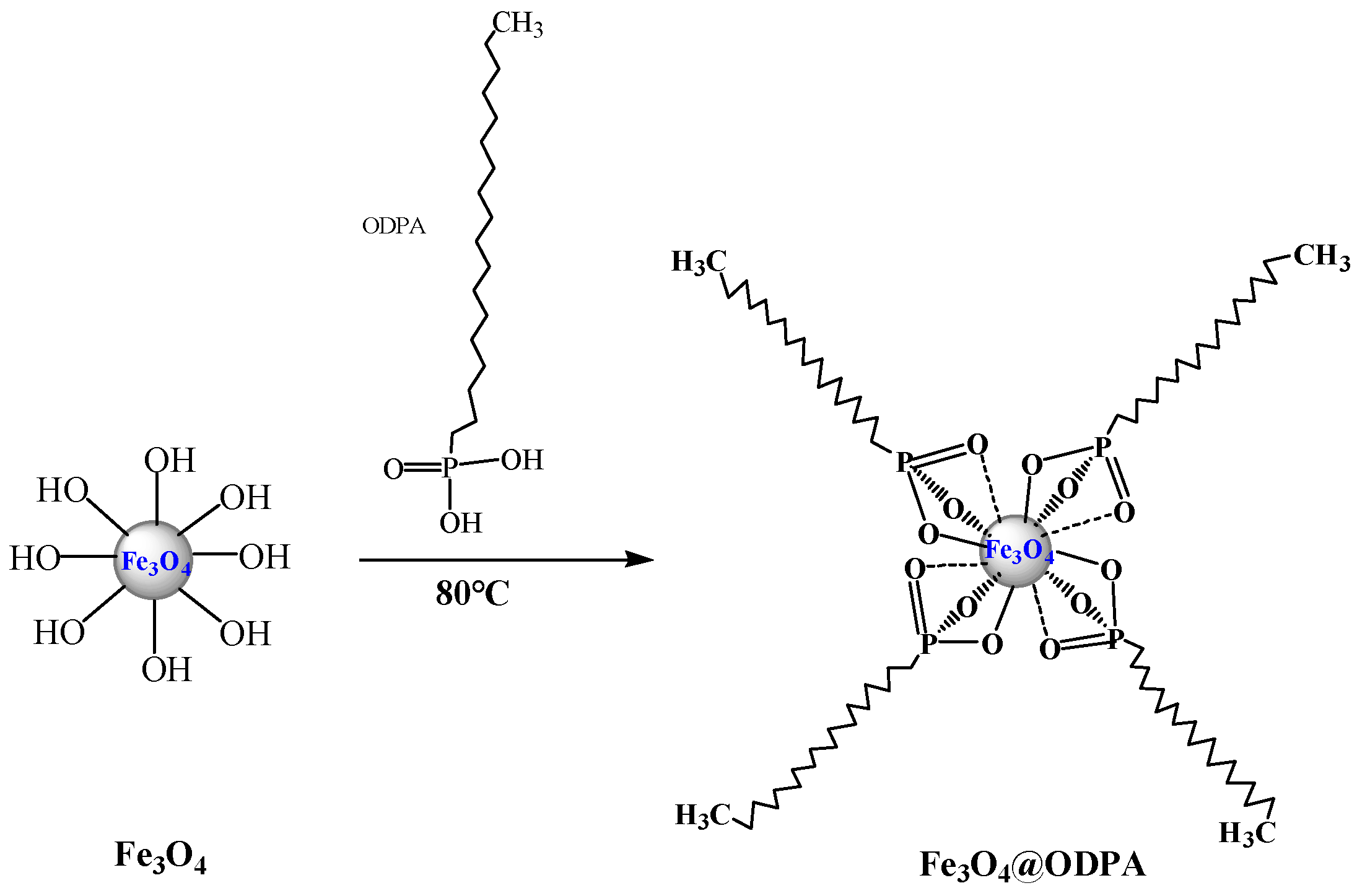
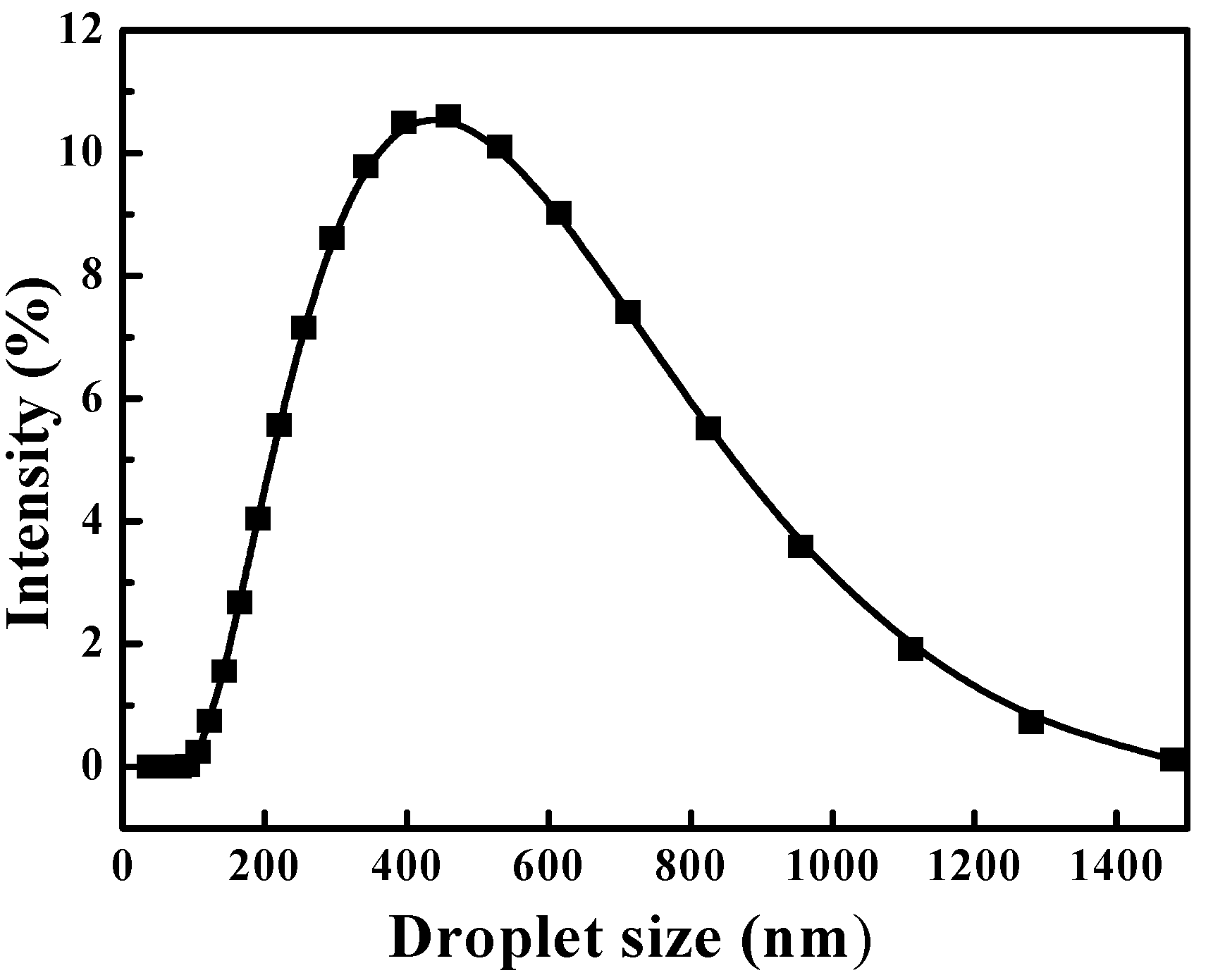
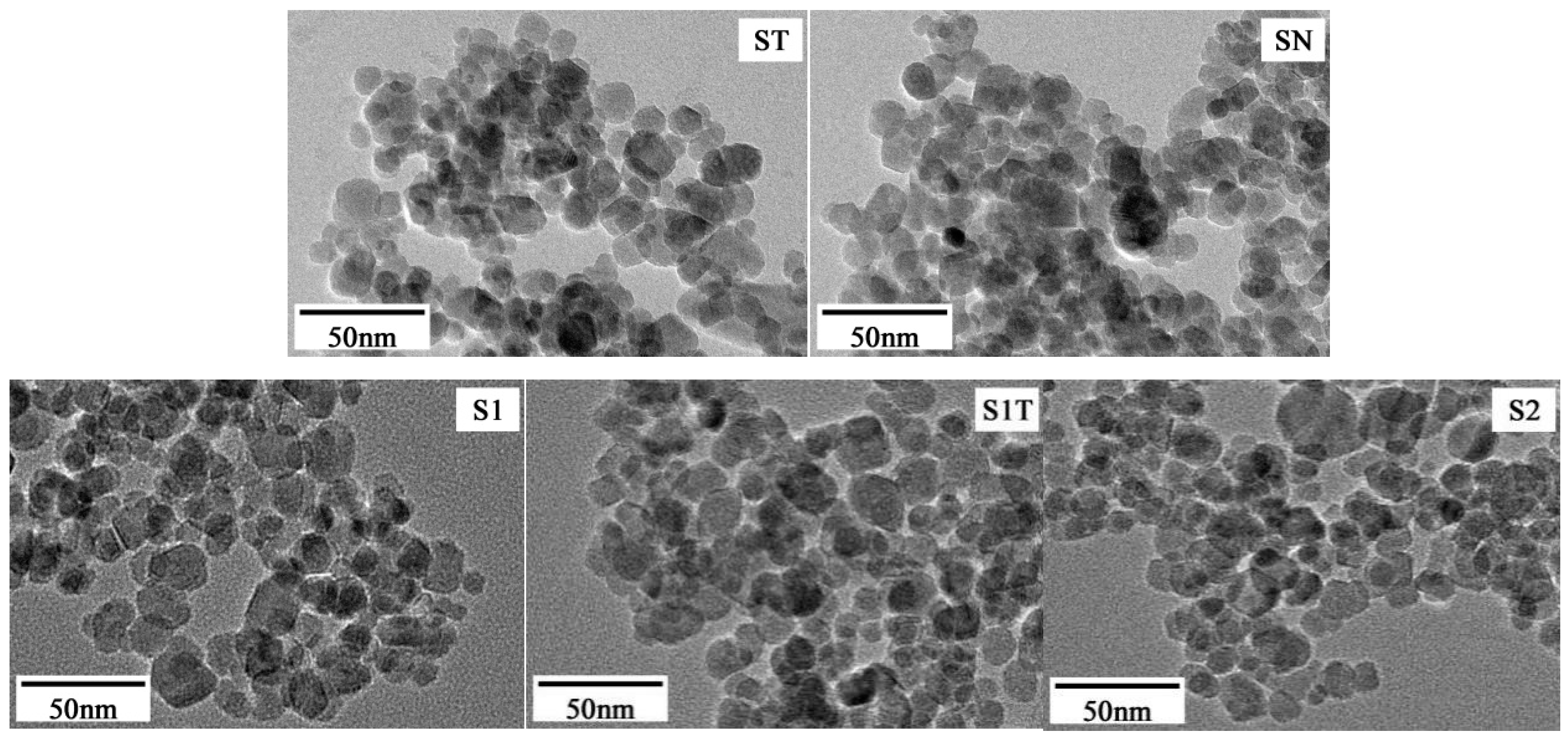


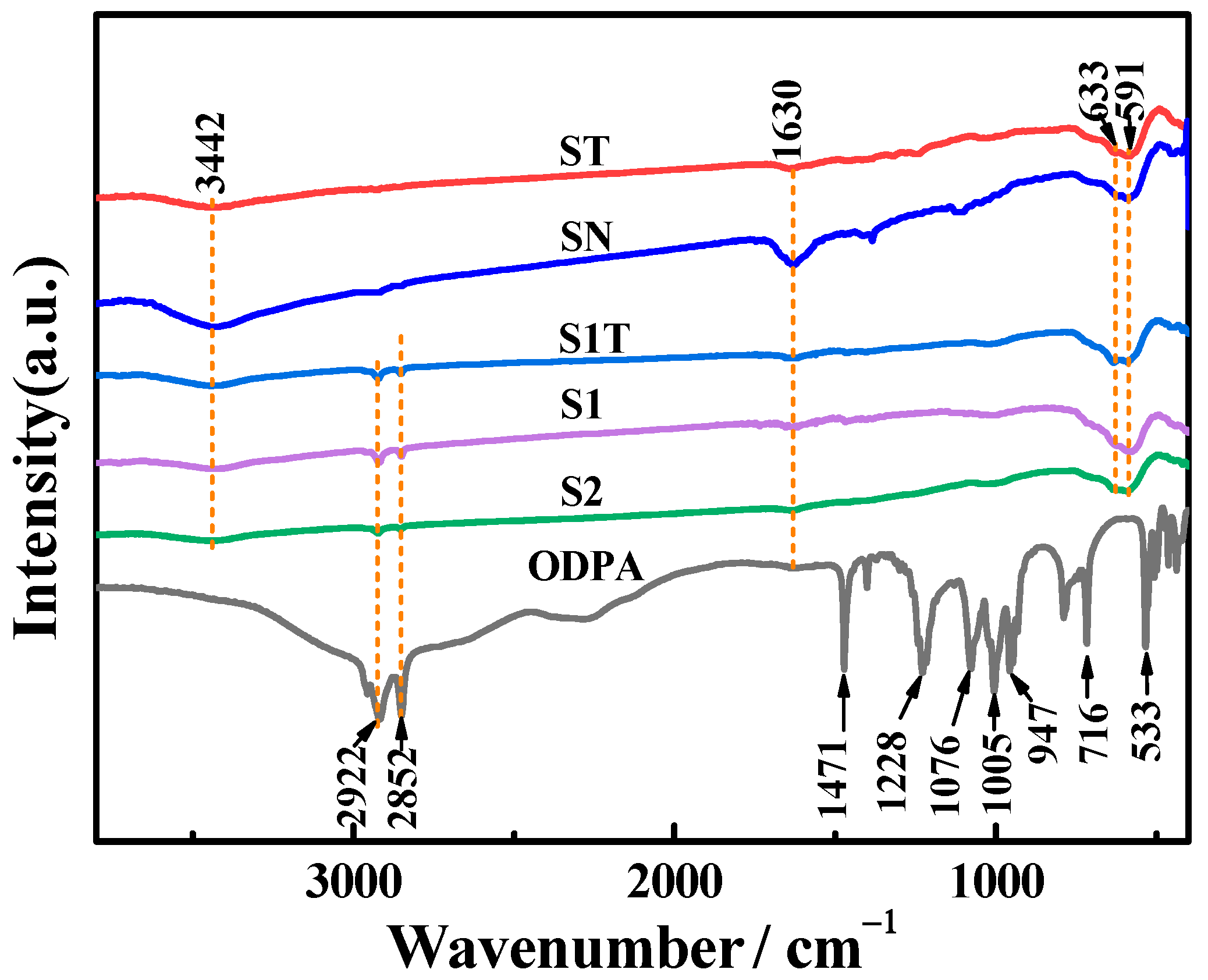
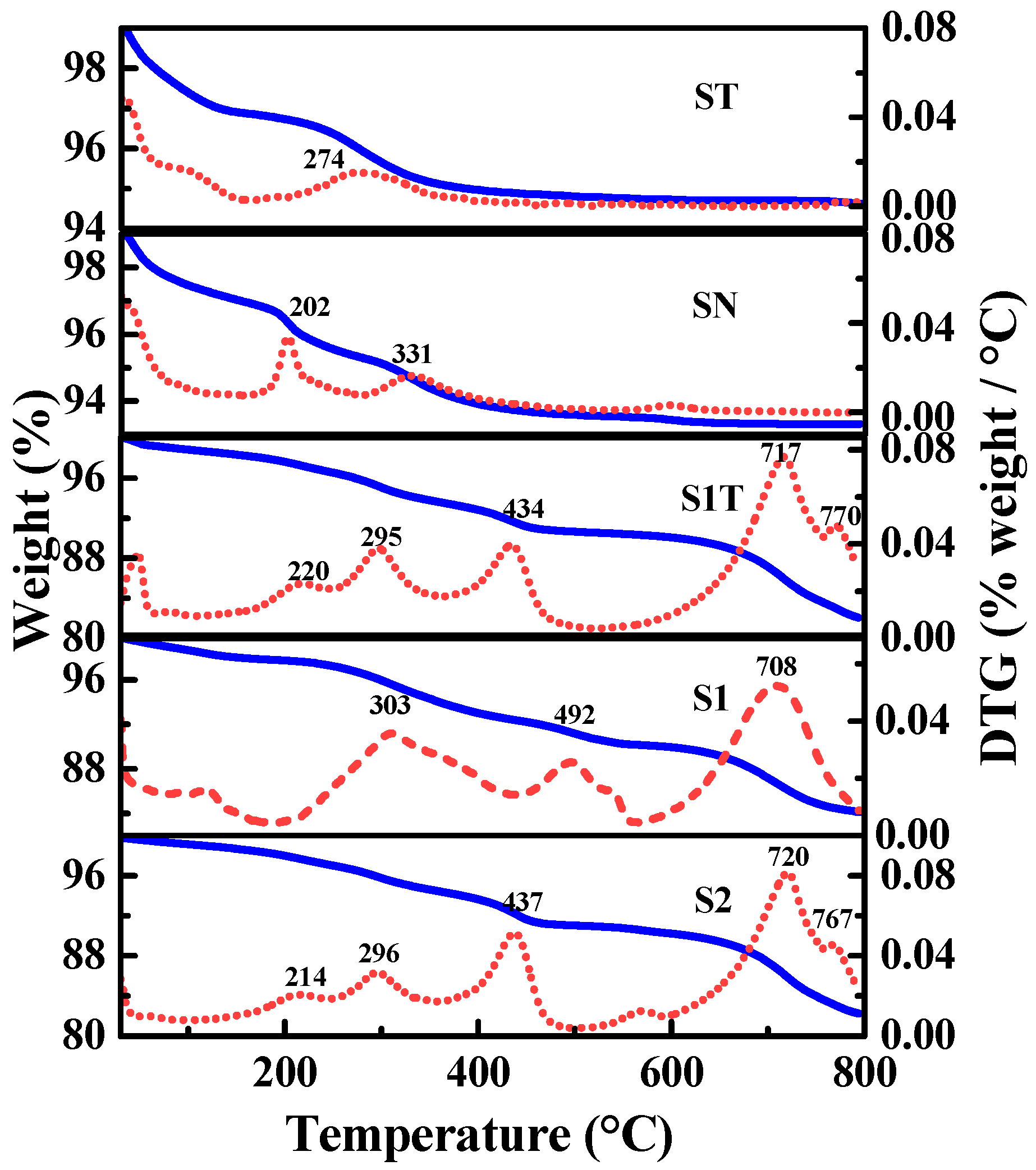
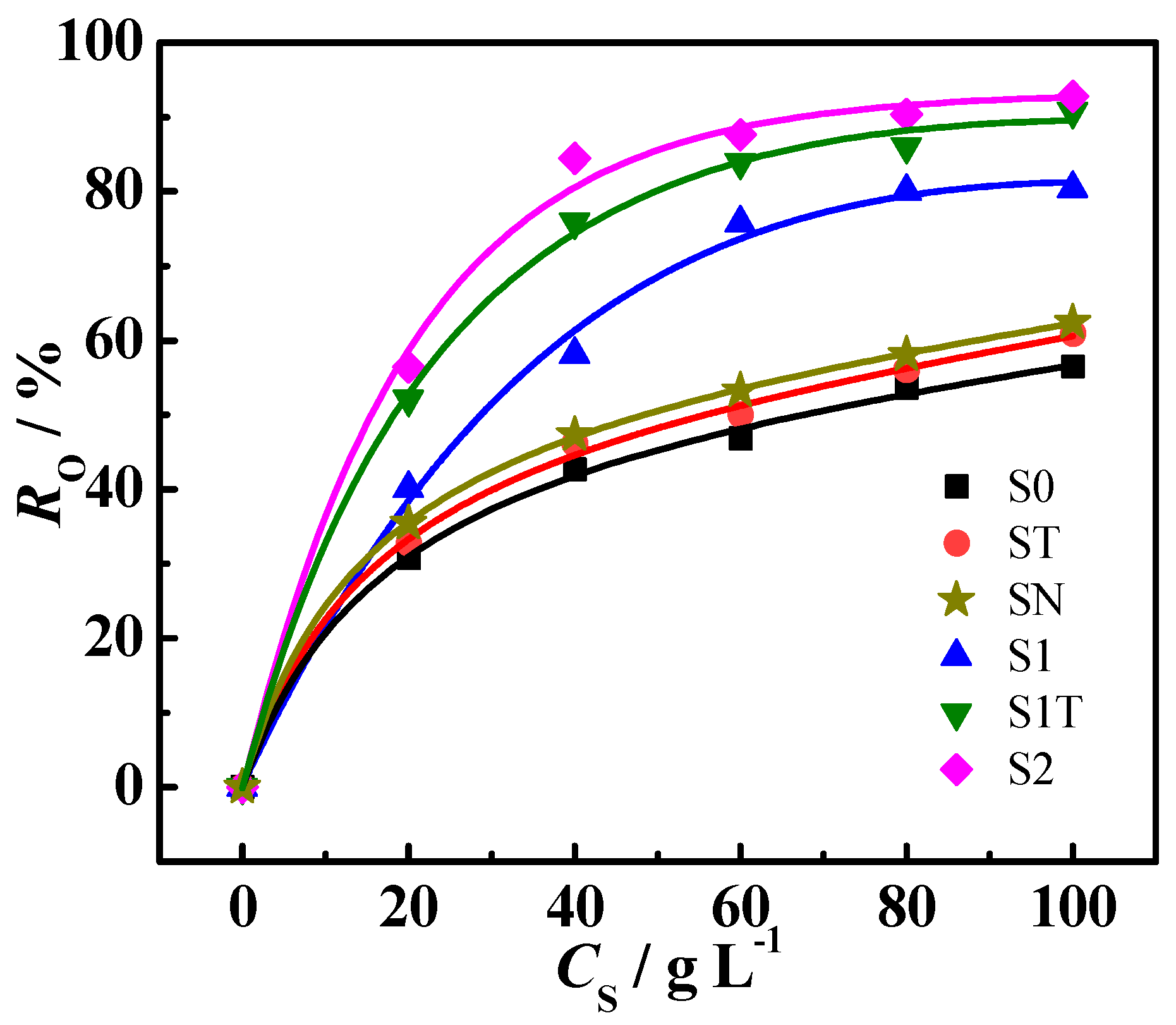
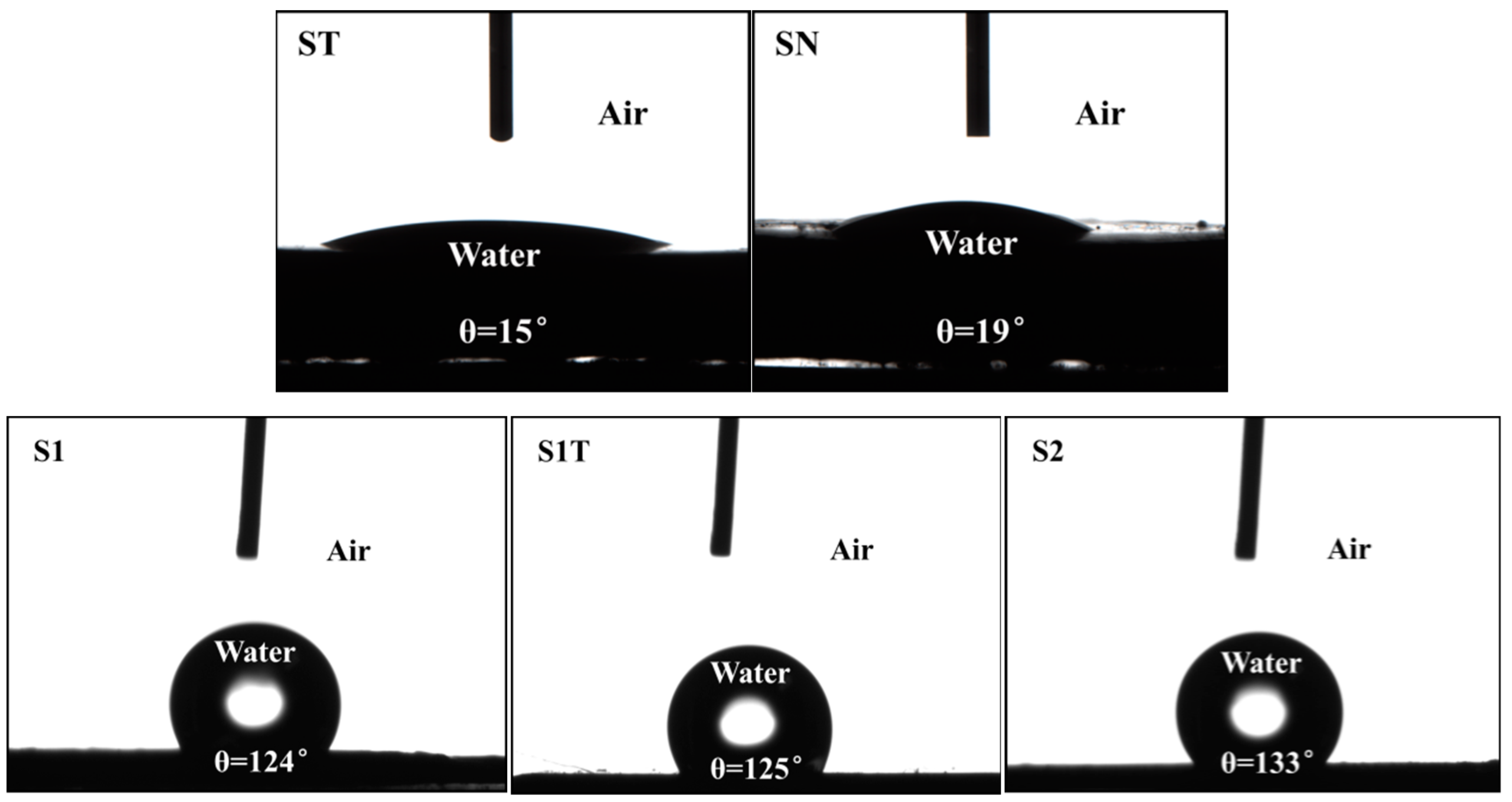
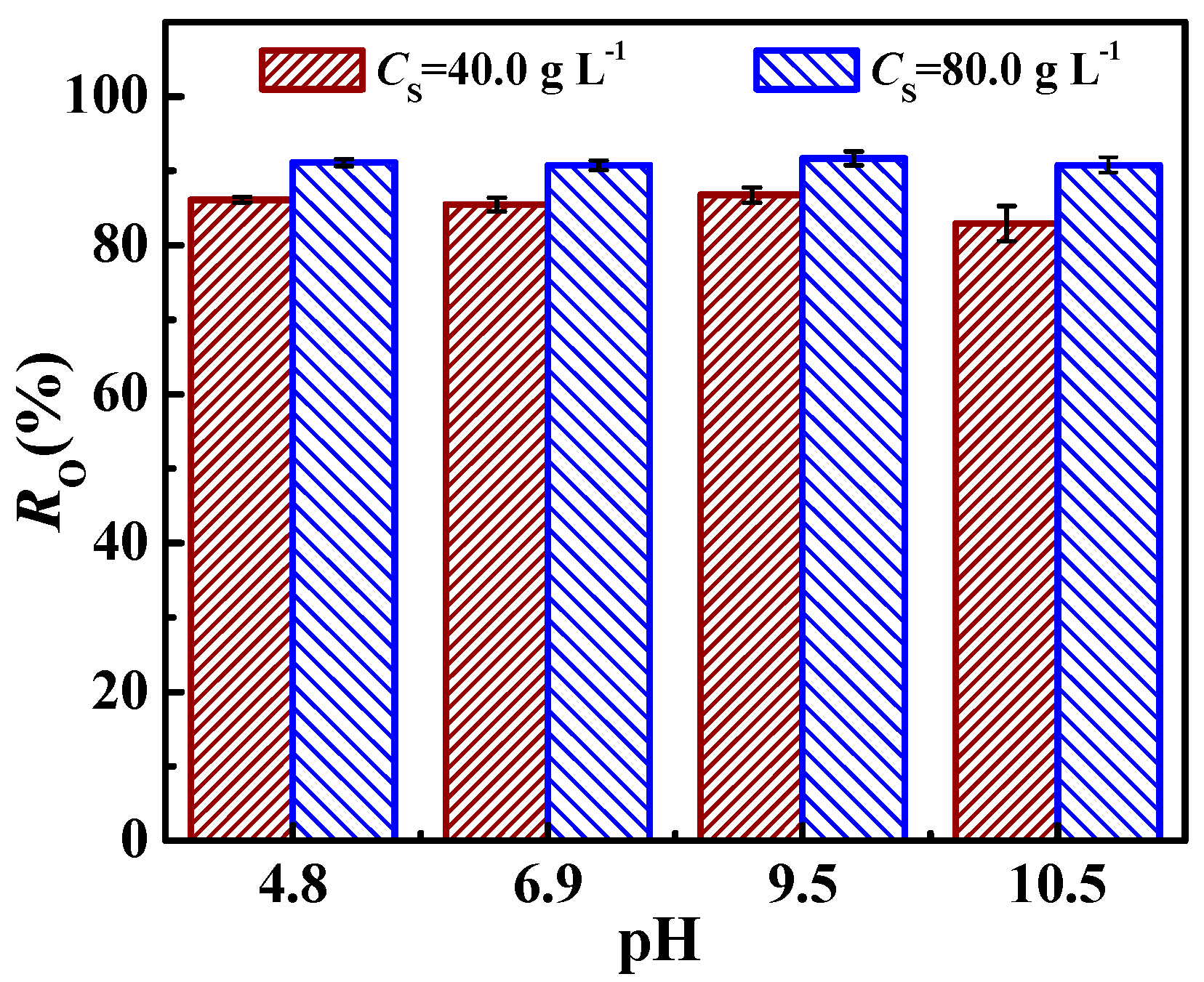
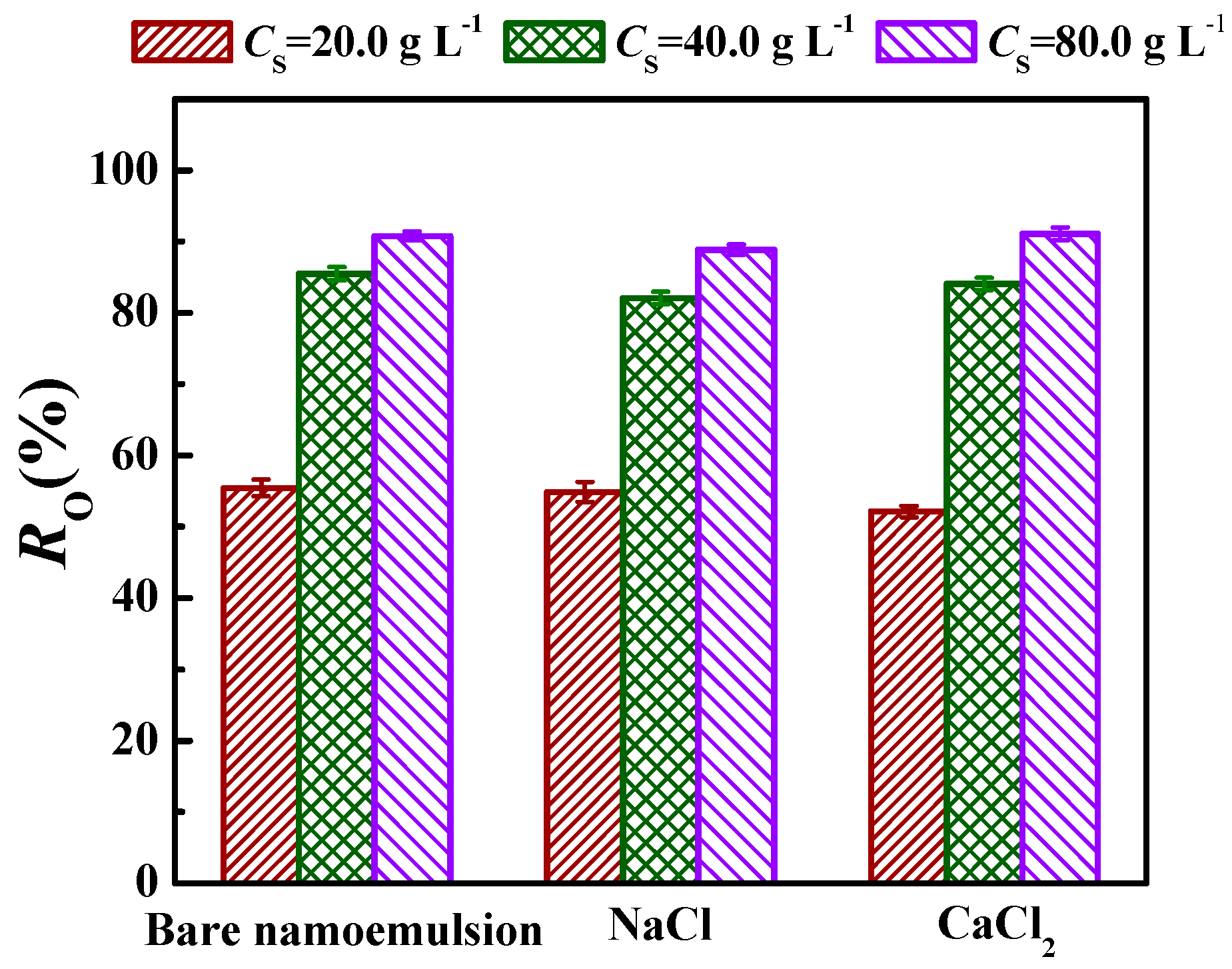
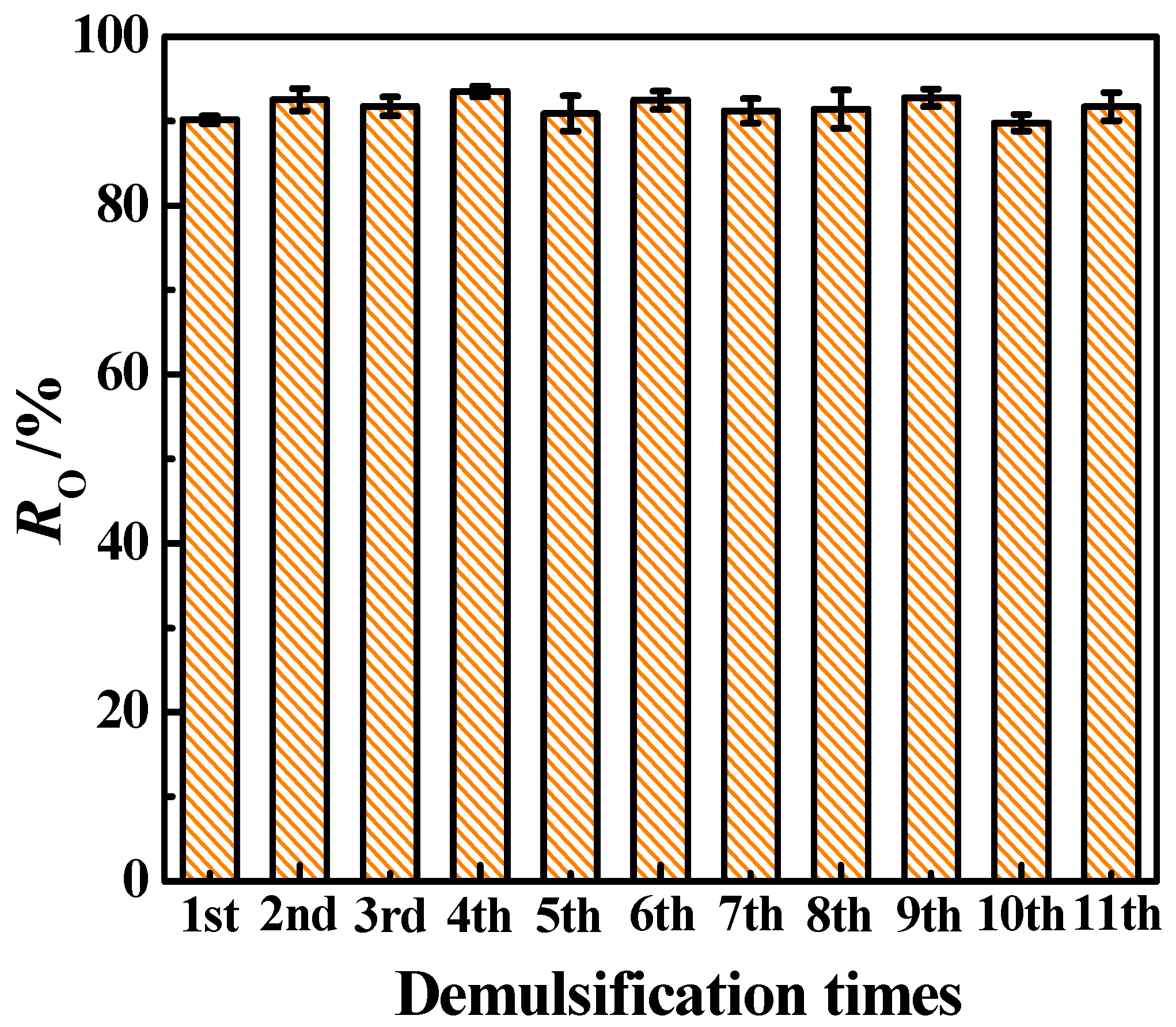
| Sample | Preparation Conditions | D (nm) | Sa (m2·g−1) | θW (°) | AO (g·g−1) | ||
|---|---|---|---|---|---|---|---|
| CTAB | Alkaline Solution | AD (g) | |||||
| ST | Presence | Absence | - | 12.0 | 142.9 | 15 | - |
| SN | Absence | Presence | - | 11.2 | 119.0 | 19 | - |
| S1 | Absence | Absence | 0.50 | 14.1 | 87.0 | 124 | 0.13 |
| S2 | Absence | Presence | 0.50 | 12.5 | 87.0 | 133 | 0.12 |
| S1T | Presence | Absence | 0.50 | 13.9 | 78.7 | 125 | 0.14 |
Disclaimer/Publisher’s Note: The statements, opinions and data contained in all publications are solely those of the individual author(s) and contributor(s) and not of MDPI and/or the editor(s). MDPI and/or the editor(s) disclaim responsibility for any injury to people or property resulting from any ideas, methods, instructions or products referred to in the content. |
© 2023 by the authors. Licensee MDPI, Basel, Switzerland. This article is an open access article distributed under the terms and conditions of the Creative Commons Attribution (CC BY) license (https://creativecommons.org/licenses/by/4.0/).
Share and Cite
Liang, J.; Han, T.; Wang, W.; Zhang, L.; Zhang, Y. Preparation of Hydrophobic Octadecylphosphonic Acid-Coated Magnetite Nanoparticles for the Demulsification of n-Hexane-in-Water Nanoemulsions. Materials 2023, 16, 5367. https://doi.org/10.3390/ma16155367
Liang J, Han T, Wang W, Zhang L, Zhang Y. Preparation of Hydrophobic Octadecylphosphonic Acid-Coated Magnetite Nanoparticles for the Demulsification of n-Hexane-in-Water Nanoemulsions. Materials. 2023; 16(15):5367. https://doi.org/10.3390/ma16155367
Chicago/Turabian StyleLiang, Jiling, Tingting Han, Wenwu Wang, Lunqiu Zhang, and Yan Zhang. 2023. "Preparation of Hydrophobic Octadecylphosphonic Acid-Coated Magnetite Nanoparticles for the Demulsification of n-Hexane-in-Water Nanoemulsions" Materials 16, no. 15: 5367. https://doi.org/10.3390/ma16155367
APA StyleLiang, J., Han, T., Wang, W., Zhang, L., & Zhang, Y. (2023). Preparation of Hydrophobic Octadecylphosphonic Acid-Coated Magnetite Nanoparticles for the Demulsification of n-Hexane-in-Water Nanoemulsions. Materials, 16(15), 5367. https://doi.org/10.3390/ma16155367







